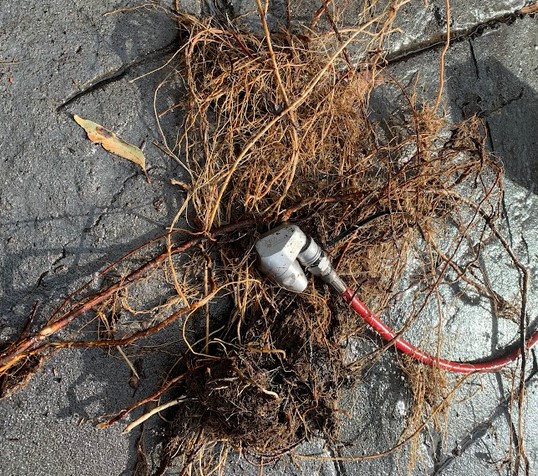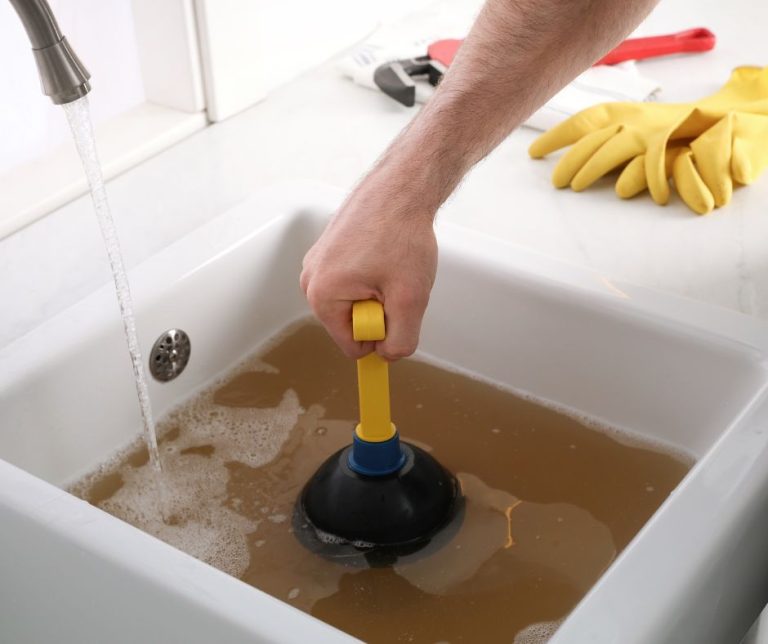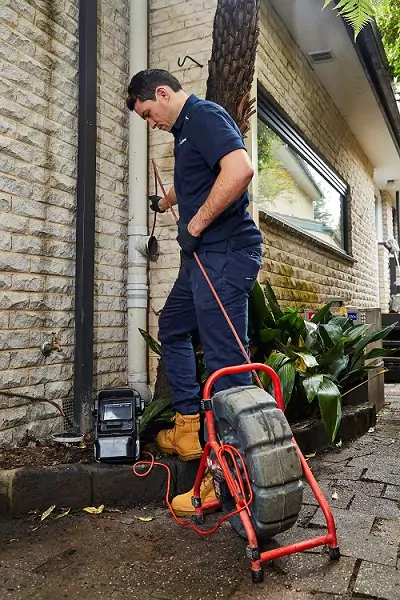Melbourne Plumbers Guide To Sewer Line Problems
A sewer line problem or blockage can be a nightmare. Not only can it cause inconvenience and disruptions in your daily routine, but it can also lead to costly repairs if left unattended.
Knowing the signs of a clogged sewer line is crucial in order to get it sorted quickly and avoid further damage.

Recognising Signs of Sewer Line Issues
It is crucial to address any signs of a clogged sewer line promptly. Whether you notice slow draining sinks and toilets, foul odors, or gurgling noises, these are all indicators that your sewer line needs attention. While some minor clogs can be resolved with DIY methods, persistent clogs, sewage backups, and lingering foul smells are clear signs that it’s time to call in the professionals.
Slow Draining
When you notice that water takes longer than usual to drain or that it accumulates around the drain, it can indicate a blockage in your sewer line.
This occurs because the clog restricts the flow of water, causing it to back up and result in slow drainage. Whether it’s your kitchen sink, bathroom sink, or toilet, if you consistently experience sluggish drainage, it’s time to investigate further.
Foul Odours
Bad smells coming from your drains are not only unpleasant but also indicate a clogged drain or sewer. As debris and waste accumulate in your pipes and allow bacteria to multiply This is what causes the smell and if you notice it coming from your drains, even after cleaning them, it’s likely that the issue lies deeper within your sewer line. Ignoring it can lead to more serious problems, such as sewage backup, so it’s crucial to address the issue promptly.
Gurgling Noises
Another telltale sign of a clogged sewer line is the presence of gurgling noises coming from your drains. If you hear strange gurgling sounds when you flush the toilet, run the dishwasher, or use any other plumbing fixture, it can signal a blockage in the sewer line. These gurgles occur when air bubbles are trapped in the pipes due to the restricted flow caused by the clog.
By not ignoring these tell tale signs, you can identify a clogged sewer or drain early on and take the necessary steps to fix it. While there are DIY methods available to tackle minor clogs, severe blockages often require a plumber.
drain cleaning services | drain pipe cleaning | kitchen sink drain cleaning
We understand that having blocked drains can be a real pain, so our team of experts is always on alert for any distress signals from your sewer line.
Now, we understand that these issues can pop up at the most inconvenient times. For that, we’ve got you covered! If you’re experiencing blocked drains near me, don’t fret. Don’t let the fear of a stubborn clog put a damper on your day.
Common Causes of Sewer Line Problems
There’s nothing pleasant about dealing with back-ups, foul odors, or the potential for costly repairs. But knowledge is power, and understanding the common causes of sewer line problems can help you prevent them and keep your plumbing in tip-top shape.
Let’s break down some of the most common culprits, shall we?
- Tree Roots: Trees love moisture, and their roots can infiltrate even the smallest cracks in your sewer line, causing serious blockages.
- Grease and Fat: When you pour grease or fats down your drain, they can solidify and build up over time, causing a stubborn clog.
- Old Pipes: Aging pipes are more prone to cracks, collapses, and corrosion, leading to sewer line issues.
- Flushing inappropriate items: From baby wipes to dental floss, flushing non-dissolvable items can wreak havoc on your sewer line.

Dealing with Clogged Drains
Dealing with clogged drains isn’t fun but there are times when some DIY methods can fix a once off blockage.
DIY Methods for Sewer Cleaning
(DIY) methods that can help keep things flowing smoothly. These methods can be effective as well as cost-effective, allowing you to tackle minor clogs and blockages without the need to call in a professional plumber.
1. Boiling water and dish soap
One of the easiest and most accessible DIY methods for clearing minor clogs in your sewer line is using boiling water and dish soap. This simple yet powerful combination can help break down grease, soap scum, and other debris that may be causing the blockage.
To use this method, start by boiling a kettle of water. While the water is heating up, squirt a generous amount of dish soap down the drain. The heat from the boiling water combined with the detergent will work together to dissolve and dislodge any buildup in the pipes.
Once the water is boiling, carefully pour it down the drain in a slow and steady stream. Be cautious not to splash yourself with the hot water. Repeat this process a few times if necessary, and you may find that the clog begins to clear.
2. Baking soda and vinegar
Another effective and natural DIY method for sewer line cleaning involves the use of baking soda and vinegar. This combination creates a fizzy reaction that can help break down organic matter and dislodge minor clogs.
To use this method, start by pouring about half a cup of baking soda down the drain. Follow it up with one cup of vinegar. You may notice a bubbling reaction, which is a sign that the mixture is working to break down the blockage.
Allow the baking soda and vinegar mixture to sit in the drain for at least 30 minutes. During this time, the reaction will continue to work its magic. Finally, flush the drain with hot water to clear away any remaining debris.
3. Using a plunger
The plunger is a classic tool for unclogging drains, and it can also be used for sewer line cleaning. This method is particularly useful for minor blockages that are causing slow draining or gurgling noises.
To use a plunger effectively, start by ensuring that there is enough water in the sink or toilet bowl to cover the rubber cup of the plunger. This water helps create a seal and allows for better suction.
Place the plunger over the drain opening and push it down firmly. Then, pull up quickly to create suction and force the water and debris out of the pipe. Repeat this plunging motion several times until you feel the blockage start to loosen.
Remember to be patient and persistent when using a plunger. It may take a few attempts before the clog is completely cleared.
By trying these DIY methods for sewer line cleaning, you can tackle minor clogs and blockages on your own.
However, it is important to note that if the problem persists or worsens, you will need to call in a plumber. They have access to seeing what is causing the blockage with a CCTV camera. It could be tree roots or a damaged pipe and no amount of DIY drain cleaning will fix that.
For more information on professional drain cleaning services, you can visit Jet Plus Plumbing’s drain cleaning services page.

Professional Sewer Line Cleaning Methods
When it comes to tackling stubborn clogs you will need a plumber and the tools that they use. We will explore three effective methods that professionals employ to ensure optimal sewer line functionality: hydro jetting, and sewer CCTV inspection.
Sewer CCTV camera inspection
A small, high-definition camera attached to a flexible cable is inserted into the sewer line through a clean out or an access point. As the camera travels through the pipe, it transmits live video footage to a monitor, enabling the plumber to visually assess the condition of the sewer line.
Sewer camera inspection offers several benefits. It allows plumbers to pinpoint the exact location and nature of a problem, eliminating the need for unnecessary digging or guesswork. By identifying potential issues early on, homeowners can proactively address them, preventing costly repairs down the line. Additionally, the recorded footage serves as valuable documentation and reference for future maintenance or insurance purposes.
Hydro jetting
This highly efficient method utilizes high-pressure water streams to break down and flush out accumulated grease, tree roots, mineral deposits, and other blockages that impede the proper flow of wastewater.
The process begins with a plumber accessing a cleanout, an access point to the sewer line. They then insert a specialized hose equipped with a multi-directional nozzle into the line. This nozzle sprays water at an incredibly high pressure, typically ranging from 1,500 to 4,000 pounds per square inch (PSI), effectively scouring the interior walls of the pipes.
Hydro jetting not only eliminates existing clogs but also helps prevent future blockages by thoroughly cleaning the entire length of the sewer line. It is a versatile solution that can be used for both residential and commercial properties, making it a go-to choice for many professional plumbers.
With these professional sewer line cleaning methods at their disposal, experienced plumbers can effectively tackle even the most stubborn clogs and ensure the optimal functionality of your sewer system.
To prevent future blockages, it is important to implement regular inspections, adopt proper waste disposal practices, and avoid grease buildup. In the next section, we will delve deeper into these preventive measures, empowering you to maintain a clean and efficient sewer line.
Continue reading: Preventive Measures for Maintaining a Clean Sewer Line
Preventing Sewer Line Backups
Preventing backups in your drainage system is a critical aspect of maintaining a healthy and functional home. These issues can lead to significant disruption and costly repairs. Remember, your home is your sanctuary. It’s where you build memories, relax, and feel the most comfortable. Let’s keep it that way.
Regular inspections
Regular inspections are key to maintaining a clean sewer line. By scheduling routine inspections with a professional plumber, you can catch any potential issues before they escalate into major problems. During these inspections, a plumber will use advanced techniques such as sewer camera inspection to assess the condition of your sewer line. This process involves inserting a camera into the sewer line to identify any blockages, cracks, or other damage. By identifying these issues early on, you can address them promptly and prevent costly repairs or replacements.
Proper disposal of waste
Improper waste disposal is one of the leading causes of sewer line clogs. It’s essential to dispose of waste materials in the appropriate manner. This means avoiding flushing items such as paper towels, feminine hygiene products, or baby wipes down the toilet. These items do not break down easily and can cause blockages in your sewer line.
In the kitchen, avoid letting food scraps or coffee grounds from going down the sink.
Scrape off food scraps into the bin before they go in the sink or dishwasher.
Avoiding grease buildup
Grease buildup is a common culprit for sewer line clogs, particularly in the kitchen. When you wash greasy dishes, pans, or utensils, it is important to take precautions to prevent grease from entering your drains. One way to do this is by scraping off excess grease and disposing of it in the trash before washing the dishes. Additionally, you can wipe greasy surfaces with a paper towel and dispose of it properly. It’s also beneficial to run hot water down the drain after each use to help flush away any residual grease. By practicing these habits, you can prevent grease buildup and maintain a clean sewer line.
By implementing these preventive measures, you can significantly reduce the risk of sewer line clogs and maintain a properly functioning system.
drain cleaning tools | drain cleaning services | drain pipe cleaning | chemical drain cleaners | kitchen sink drain cleaning

When to Call a Professional Plumber
While there are several DIY methods for sewer line cleaning, there are instances when it’s best to leave the job to the professionals. Here are three situations where you should call a professional plumber:
Persistent clogs
Persistent clogs can be a frustrating problem to deal with. If you’ve tried various DIY methods to clear the clog, but it keeps coming back, it’s time to call in the experts.
A professional plumber can use hydro jetting to effectively remove stubborn blockages that are building up within the pipes.
Sometimes there is a problem with the actual pipes and you may need to have pipes replaced
- Structural damage: Over time, sewer pipes can suffer from structural damage due to factors such as corrosion, root intrusion, ground movement, or aging. High-pressure jetting may clear the immediate blockage but cannot address underlying structural issues. In such cases, pipe replacement is necessary to restore the integrity of the sewer system.
- Inadequate pipe slope: When pipes are laid at the wrong angle, resulting in inadequate or insufficient slope or fall. The proper slope or gradient is crucial in sewer systems to ensure the smooth flow of wastewater and prevent blockages or backups. The correct slope allows gravity to assist in moving the wastewater towards the desired direction, usually a sewer main or a treatment facility.
- Pipe deterioration: Sewer pipes can deteriorate over time due. High-pressure jetting may temporarily clear blockages, but it won’t address the underlying deterioration. In such cases, pipe replacement becomes necessary to rectify both the deteriorated pipes and the improper pipe grading.
- System upgrades or capacity issues: If a sewer system requires upgrades to accommodate increased capacity or meet regulatory requirements, simply cleaning the pipes may not be sufficient. Replacement might be necessary to install larger or more efficient pipes, addressing the overall system needs and ensuring optimal performance.
It’s important to note that the determination of whether sewer pipes should be replaced instead of cleaned with high-pressure jetting, considering factors such as improper pipe grading, should be made by qualified plumbers or sewer specialists who can assess the specific conditions and needs of the sewer system.
Sewage backup
A sewage backup is not only unpleasant but also poses a serious health risk. If you notice water or sewage coming back up through your drains or toilets, it’s crucial to contact a professional plumber immediately. Sewage backups can be caused by a clogged sewer line or a more severe issue within your plumbing system. Attempting to resolve this problem on your own can lead to further damage and contamination. A professional plumber will have the expertise to identify the source of the backup and provide the necessary drain cleaning services or repairs.
Foul smells that won’t go away
Persistent foul odors in your home, particularly near drains or toilets, can indicate a sewer line problem. If you’ve tried simple remedies like cleaning the drains or using deodorizers, but the smell persists, it’s time to call in a professional plumber. They can conduct a thorough inspection using a sewer camera to identify any underlying issues such as blockages or damage to the sewer line. With their expertise, they can then recommend the appropriate course of action, whether it’s drain pipe cleaning or repairs.
Remember, when it comes to these three situations – persistent clogs, sewage backup, and foul smells that won’t go away – it’s best to seek professional help. By doing so, you can ensure that your sewer line is properly cleaned and maintained, avoiding potential health hazards and costly repairs in the long run.
Click here to learn more about professional drain cleaning services.

Conclusion
In conclusion, maintaining a clean sewer line is vital for the overall health and functionality of your plumbing system. By regularly cleaning your sewer line, you can prevent costly and inconvenient clogs, backups, and foul odors.
If you find yourself in need of professional help, don’t hesitate to reach out to us at Jet Plus Plumbing. Our expertise and specialised drain cleaning tools can effectively clear even the most stubborn clogs and ensure the long-term health of your sewer line.








